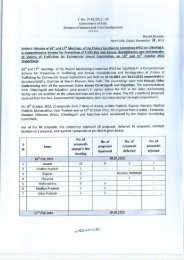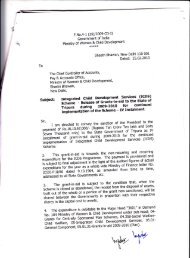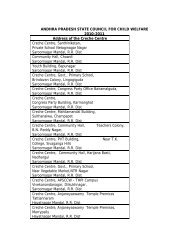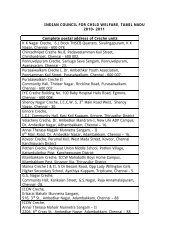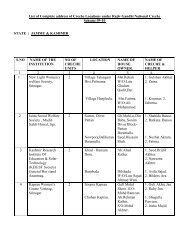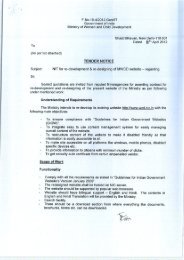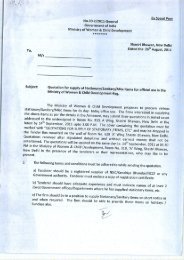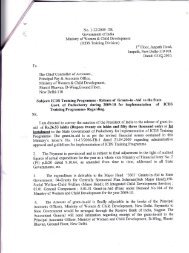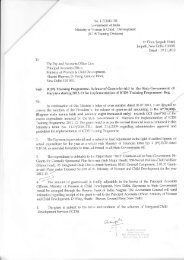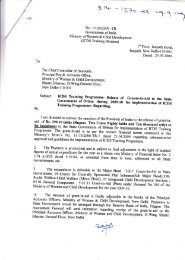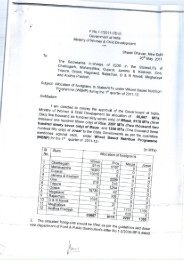COVER HINDI - Ministry of Women and Child Development
COVER HINDI - Ministry of Women and Child Development
COVER HINDI - Ministry of Women and Child Development
- TAGS
- hindi
- ministry
- wcd.nic.in
You also want an ePaper? Increase the reach of your titles
YUMPU automatically turns print PDFs into web optimized ePapers that Google loves.
(iii) to reduce the incidence <strong>of</strong> mortality, morbidity, malnutrition<br />
<strong>and</strong> school drop-outs;<br />
(iv) to achieve effective coordination <strong>of</strong> policy <strong>and</strong><br />
implementation among various departments to<br />
promote child development;<br />
(v) to enhance the capability <strong>of</strong> the mother to look after<br />
the normal health <strong>and</strong> nutritional needs <strong>of</strong> the child<br />
through proper health <strong>and</strong> nutrition education.<br />
Services: The Scheme provides a package <strong>of</strong> following<br />
services to children below 6 years <strong>and</strong> pregnant & lactating<br />
mothers from disadvantaged sections:<br />
(i) supplementary nutrition<br />
(ii) immunization<br />
(iii) health check-up<br />
(iv) referral services<br />
(v) pre-school non-formal education <strong>and</strong><br />
(vi) nutrition & health education<br />
Pattern: It is an ongoing Centrally sponsored scheme<br />
implemented through the State Governments with 100 per<br />
cent financial assistance from the Central Government for<br />
all inputs other than supplementary nutrition which the<br />
States were to provide from their own resources. However,<br />
from the year 2005-06, the Government <strong>of</strong> India has been<br />
providing Central assistance to States for supplementary<br />
nutrition also to the extent <strong>of</strong> 50% <strong>of</strong> the actual expenditure<br />
incurred by States or 50% <strong>of</strong> the cost norms, whichever is<br />
less.<br />
Population Norms<br />
Existing Norms: The Scheme envisages that the<br />
administrative unit for the location <strong>of</strong> ICDS Project will<br />
be the CD Blocks in rural areas, tribal blocks in tribal<br />
areas <strong>and</strong> ward(s) or slums in urban areas. An Anganwadi<br />
Centre is sanctioned on an average, for 1,000 population<br />
in rural/urban projects <strong>and</strong> 700 population in tribal Project,<br />
with suitable adjustments, wherever necessary, in the light<br />
<strong>of</strong> local conditions.<br />
Sparsely populated hilly/desert areas: In hilly or desert<br />
areas, which may be sparsely populated, villages may be<br />
very small or divided into small hamlets. In such cases, an<br />
Anganwadi may be set up in a village or a hamlet having a<br />
population <strong>of</strong> 300 or more.<br />
Mini-AWCs : Mini Anganwadi Centre can be set up to<br />
cover the remote <strong>and</strong> low populated hamlets/villages in<br />
tribal blocks, having a population between 150 to 300.<br />
Revised Norms: An Inter-Ministerial Task Force<br />
was set up in 2004 to review the existing population norms<br />
for sanction <strong>of</strong> an ICDS Project/AWC <strong>and</strong> suggest revised<br />
norms. The Task Force Submitted its reports /<br />
recommendations in May 2005. The revised population<br />
norms recommended by the Task Force are as follows:<br />
Project: CD block in a State should be the unit for sanction<br />
<strong>of</strong> an ICDS Project, in rural/tribal areas, irrespective <strong>of</strong><br />
number <strong>of</strong> villages/population in it.<br />
Anganwadi Centre (For Rural projects)<br />
Population<br />
500-1500 - 1 AWC<br />
150-500 - 1 Mini AWC<br />
Population<br />
(For Tribal Projects)<br />
300-1500 - 1AWC<br />
150-300 - 1 Mini AWC<br />
[For habitation with less than 150 population, specific<br />
proposal should be submitted by the State Governments<br />
for consideration <strong>and</strong> appropriate decision by the<br />
Government <strong>of</strong> India.]<br />
Population<br />
(For Urban Projects)<br />
500-1500 - 1 AWC<br />
48 Annual Report 2006-07



